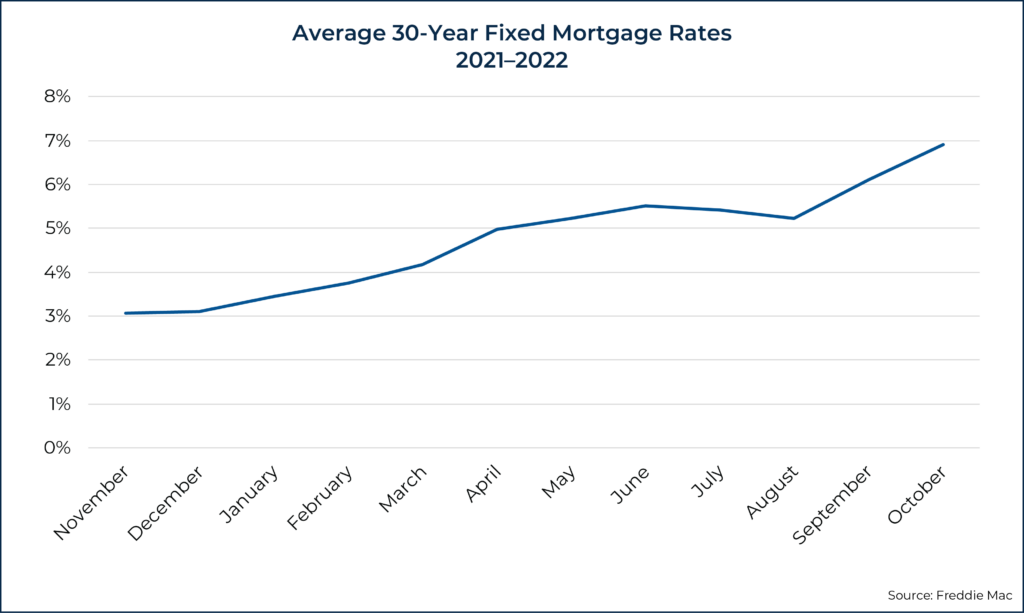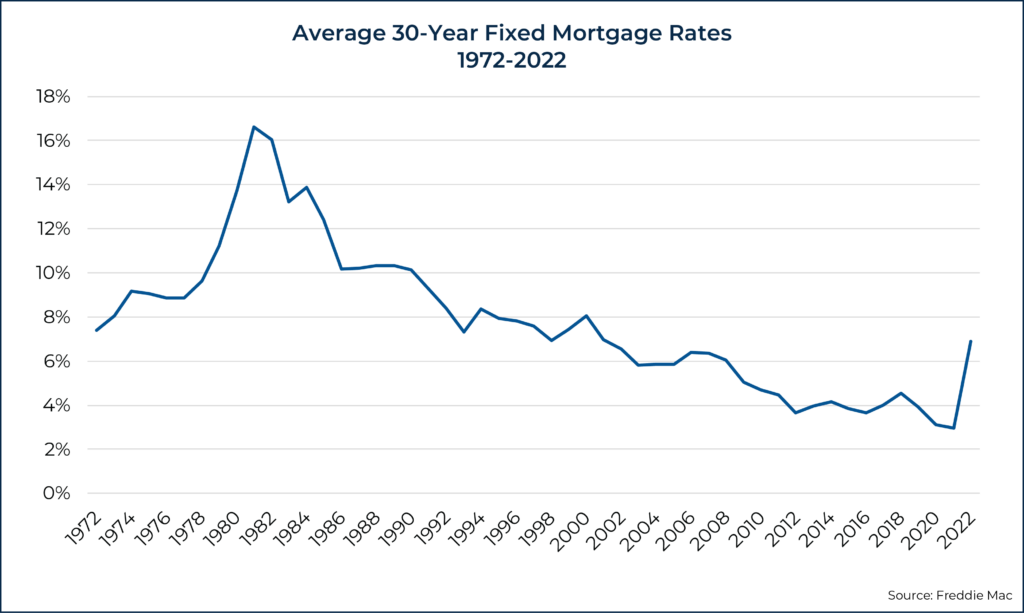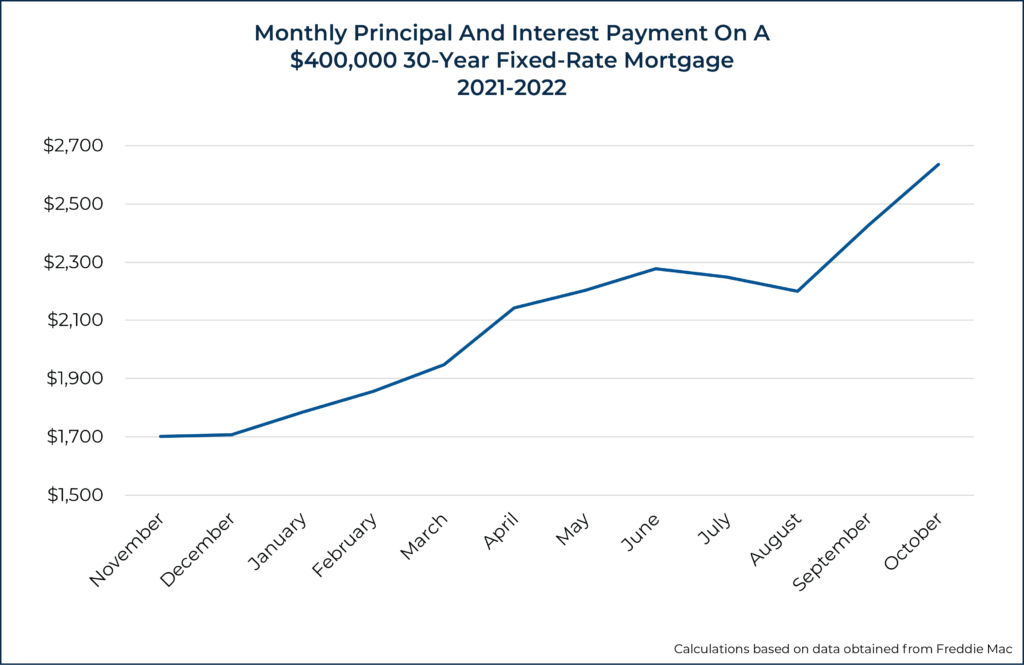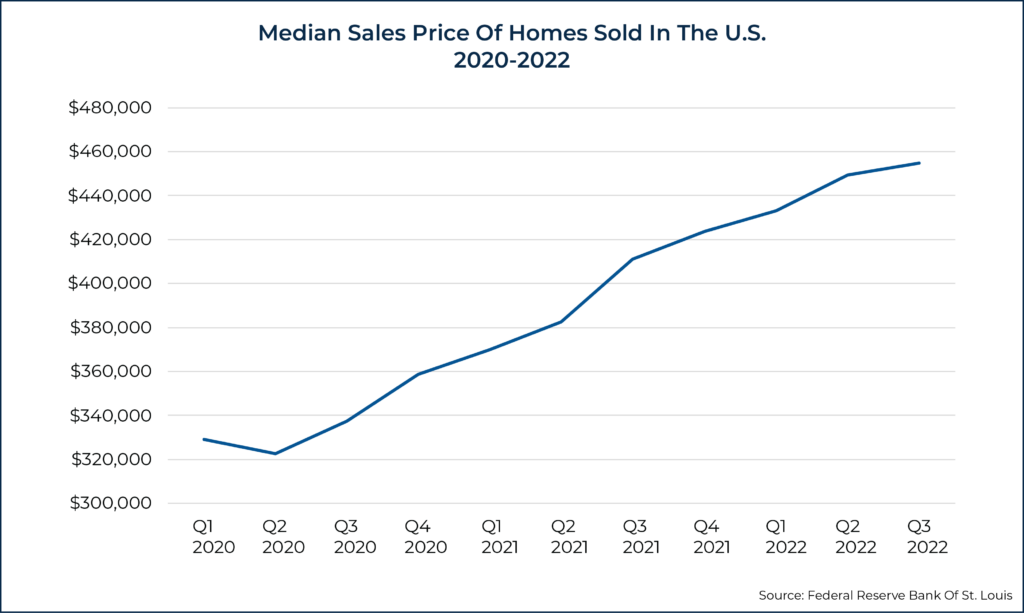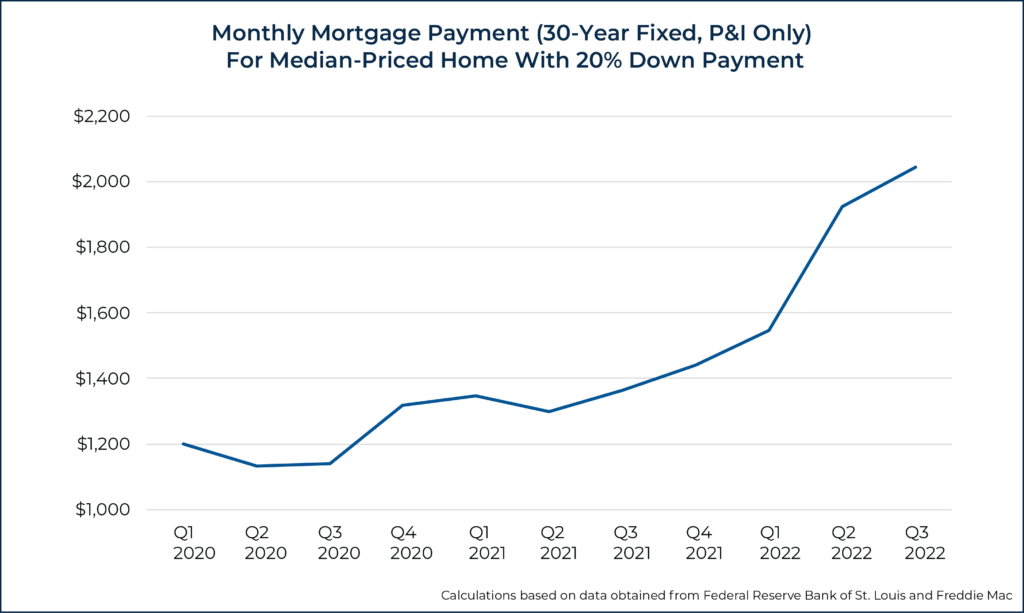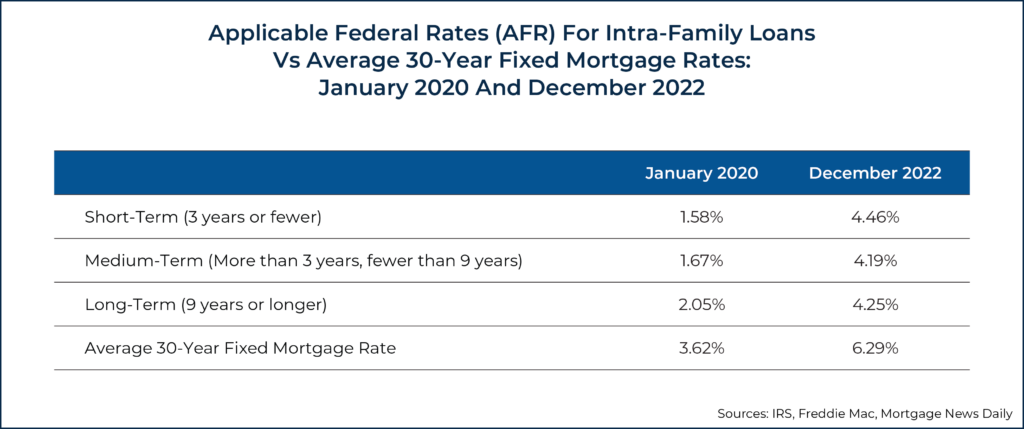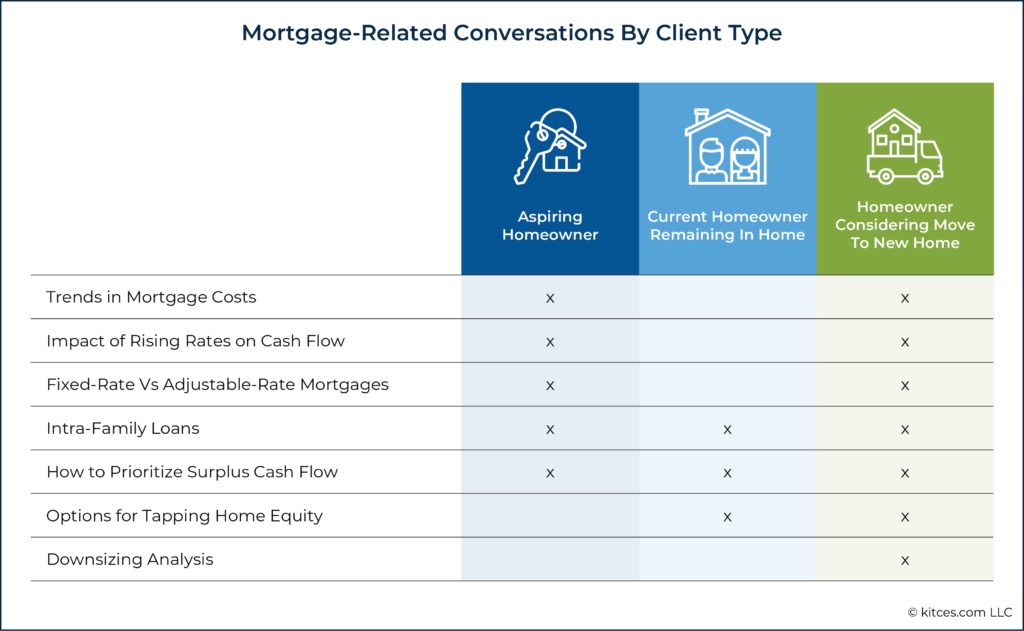Executive Summary
Leading up to 2022, financial advisors and their clients had grown accustomed to a relatively low mortgage rate environment. In fact, until earlier this year, the average 30-year fixed mortgage rate had stayed below 5% since 2010 (and below 7% since 2001). But as the Federal Reserve has sought to raise interest rates this year to combat inflation, mortgage rates have reached higher levels not seen in more than 20 years, with 30-year fixed mortgages reaching an average of 6.9% in October 2022, twice the 3.45% average rate in January.
While the plight of today’s first-time homebuyers facing higher mortgage rates has attracted much media attention (deservedly so, as the monthly payment on a 30-year fixed mortgage for the median-priced home in the U.S. increased by nearly $1,000 in the past year), higher interest rates can affect financial planning calculations for current homeowners as well. For instance, higher interest rates have raised the borrowing costs for those looking to tap their home equity through a home equity loan or a Home Equity Line Of Credit (HELOC), and older homeowners considering a reverse mortgage will also be subject to higher interest rates.
At the same time, higher interest rates can present opportunities for some individuals. For example, those who are interested in making an intra-family loan could generate more income from the higher Applicable Federal Rates (while the loan recipient benefits from a rate significantly lower than standard mortgage rates). In addition, many current homeowners could have mortgages with rates lower than the ‘risk-free’ rate of return now available on U.S. government debt, which has risen alongside broader interest rates (perhaps changing the calculus of whether to pay down their mortgage early). And current homeowners with significant equity could consider downsizing and buying a smaller home in cash, potentially benefiting from a less-competitive housing market while not having to take out a mortgage at the current rates.
Ultimately, the key point is that a higher interest-rate environment affects not only homebuyers looking to purchase a home for the first time but also those who are current homeowners. Further, given that a home can be considered a consumption good (that often comes with emotional attachments) as well as an asset on the homeowner’s net worth statement, advisors can also add value by helping clients explore their home-related goals and assessing the financial tradeoffs of purchasing a more or less expensive home with a mortgage in a higher rate environment (or, if they have the means, whether buying a home in cash might be appropriate!). Regardless of whether a client is an aspiring first-time homebuyer or considering downsizing in retirement, advisors can add value by helping their clients navigate higher mortgage-rate environments!
Leading up to 2022, financial advisors and their clients had grown accustomed to a relatively low mortgage rate environment. In fact, until earlier this year, the average 30-year fixed mortgage rate had stayed below 5% since 2010 (and below 7% since 2001). But as the Federal Reserve has sought to raise interest rates this year to combat inflation, mortgage rates have reached levels not seen in more than 20 years, with 30-year fixed mortgages reaching an average of 6.9% in October, twice the 3.45% average rate in January.
For individuals who were of homebuying age during the 1970s and 1980s, a near-7% rate might not sound so bad, as mortgage rates in those years were typically above 10%, reaching an average annual rate of 16.6% in 1981 (and a monthly peak of nearly 18.5% in October of that year!). In fact, the average 30-year mortgage rate between 1972 and 2022 was about 7.8%, meaning that while today’s mortgage rates are relatively higher than those experienced during the last decade, they are actually lower than the average during the past 50 years (perhaps suggesting that the sub-4% rates seen in the past few years were more of an anomaly than today’s elevated rates).
Though, notably, while the plight of today’s first-time homebuyers facing higher mortgage rates has attracted much media attention, higher interest rates can affect financial planning calculations for advisors with clients who are already current homeowners as well. For instance, higher interest rates have raised the borrowing costs for those looking to tap their home equity through a home equity loan or a Home Equity Line Of Credit (HELOC), and older homeowners considering a reverse mortgage will be subject to a higher interest rate as well.
Altogether, given the wide range of individuals affected by higher interest rates, financial advisors have many new opportunities to add value for their clients by explaining the important planning considerations in our current higher-interest-rate environment.
The Impact Of Increased Costs On Cash Flow And Homebuying Decisions
For many clients, buying a home is a common long-term goal. Whether they are looking to buy a home for the first time or sell their current home to buy a new one, advisors can add value by showing them how the home purchase will impact their overall financial plan (including other goals) and any potential cash flow changes they might need to make (e.g., increasing cash savings to cover the down payment) to be able to make the home purchase. But rising interest rates can complicate this decision (as the cost of taking out a mortgage has increased dramatically!), and advisors and clients can work together to decide whether they want to change the home price and interest-rate assumptions underlying their clients’ homebuying goals.
For instance, assuming the same purchase price, the required monthly payment (principal and interest only) on a $400,000 mortgage has increased significantly in the past year due to rising interest rates, rising from about $1,700 in November 2021 to $2,634 in October 2022.
Unfortunately for homebuyers (particularly those looking to sell their current homes whose values have not appreciated), rising interest rates have coincided with increasing home prices, with the median sales price of homes sold increasing from $329,000 in the first quarter of 2020 to $454,900 in the third quarter of 2022. Which means that not only are homebuyers faced with increasing costs to finance their new home, but they are also in need of more financing to manage their new purchase!
Together, rising interest rates and home prices have increased mortgage payments for homebuyers. For example, given the median home purchase price in the first quarter of 2020 was $329,000 and rose to $454,900 in the third quarter of 2022, a homebuyer making a 20% down payment on the median home price with the prevailing average 30-year fixed mortgage rate at the time of purchase would have seen their monthly principal and interest payment jump from $1,200 in the first quarter of 2020 to $2,046 in the third quarter of 2022 (and possibly increased further, as the average interest rate jumped to 6.9% in October 2022)!
In addition to a larger monthly mortgage payment, rising prices usually mean that homebuyers have to save more for down payments as well. For instance, a homebuyer making a 20% down payment on the median-priced home in the third quarter of 2022 would have had to save $25,100 more ($90,980 compared to $65,800) than a homebuyer in the first quarter of 2020, and this number would only increase for those buying higher-priced homes.
Notably, one small bright spot for savers is that higher interest rates have translated to greater returns on savings accounts (from sub-1% before the broader interest rate increase to more than 3% at some banks), facilitating their ability to save for a down payment.
The key point is that the dramatic increase in both home prices and mortgage rates in the past couple of years presents a challenge for individuals in the market for a new home. While the future trajectories of home prices and mortgage rates are unclear, advisors can help their clients by revisiting the home purchase price and mortgage rate assumptions in their financial plans. Because higher interest rates (and home prices) affect not only the amount of savings a homebuyer needs for a down payment, but also their long-term cash flow (given the mortgage payment is typically their largest expense) and the assets they will have available in the distant future!
Nerd Note:
The above discussion focuses only on the principal and interest portion of mortgage payments, but increased home prices could also increase property taxes and home insurance costs. On the other hand, the increased interest for mortgages in a higher-rate environment could be partly offset by the deductibility of the mortgage interest; though, for many individuals, this benefit could be limited due to the increased standard deduction and State And Local Tax (SALT) cap included in the Tax Cuts and Jobs Act of 2017.
Deciding Between Fixed-Rate And Adjustable-Rate Mortgages (ARMs)
When shopping for a mortgage, prospective homebuyers have the option of choosing between a fixed-rate mortgage, where the interest rate is set for the length of the loan, typically 15 or 30 years, or an Adjustable-Rate Mortgage (ARM), where the interest rate is set for a certain number of years, often 3 to 10 years, after which the interest rate on the outstanding balance resets periodically. Typically, interest rates are lower on ARMs (for the period when the rate is fixed) than fixed-rate mortgages but come with the risk of readjusting to a significantly higher interest rate after the initial fixed-rate period ends (meaning that the homeowner could end up paying more over the life of an ARM loan than if they had taken a fixed-rate mortgage).
Given the historically low mortgage rates experienced during the past decade, fixed-rate mortgages were much more common than ARMs, as homebuyers preferred to lock in low rates with fixed mortgages instead of taking a chance that rates could rise in the future. But this calculus appears to be changing with the dramatic rise in interest rates seen in 2022. For instance, as of May 2022, ARMs made up more than 10% of total mortgage loans for the first time since 2008, as homeowners have sought to benefit from the reduced (initial) rate compared to fixed-rate loans (e.g., as of mid-December 2022, the rate on a 30-year fixed-rate mortgage was 6.39%, versus the initial rate of 5.90% on a 5/1 ARM [which has a rate that is fixed for the first 5 years and then adjusts annually for the remainder of the loan]).
At the same time, the decision of whether to use an ARM versus a fixed-rate mortgage is often made based on considerations that go beyond the initial interest rate. These include homeowner-specific factors such as the length of time the individuals expect to live in the home (e.g., those planning to only stay in the home for 5 to 7 years might prefer an ARM given the benefits of the lower rate compared to a fixed-rate mortgage) as well as their willingness to take the risk of rising ARM rates after the initial interest-rate period (and their ability to make potentially larger mortgage payments!).
It is also worth noting that the decision to choose a fixed-rate mortgage or an ARM is not permanent, as mortgage holders could have the opportunity to refinance their loan to a lower rate if broader interest rates were to decline. But while current mortgage rates are elevated compared to rates from the previous decade, they remain below their 50-year average (about 7.8%), suggesting that it might not be prudent for homebuyers and their advisors to assume they will be able to get a lower rate in the future (particularly one that is sufficiently lower than their current rate to compensate the borrower for the time and monetary costs of refinancing).
In sum, while ARMs have become attractive to many homebuyers in the higher rate environment (thanks to their lower rates compared to fixed-rate mortgages, as well as the potential for future mortgage rate declines that could allow homeowners to refinance to a lower rate), advisors can add value to their clients by discussing the various dimensions of the decision – from considering how long they plan to spend in the home to putting current interest rates in historical perspective – to help them make the best choice for their specific circumstances!
Considering Intra-Family Loans
Helping a child (or grandchild) purchase their first home is a common goal of many financial advisory clients who are parents and grandparents. But when supporting a child or grandchild, it is important to keep in mind the Internal Revenue Code’s annual gift tax exclusion limit ($17,000 in 2023) to avoid using any of the giver’s lifetime gift tax exemption, which could potentially increase future estate tax exposure. Notably, the gift tax exclusion is determined on an individual basis, so, for example, each parent could gift their child $17,000 (for a total of $34,000) in 2023 without gift tax consequences, which could help cover a down payment but is highly unlikely to cover the full cost of a home.
For family members who want to make a larger contribution to a home purchase without creating gift tax consequences, an alternative option is to finance the home through an intra-family loan. The key to intra-family lending is that, for the loan to be honored by the IRS (i.e., not be considered a gift), it must be treated as a bona fide loan, including loan terms at a “market” rate of interest that should be at least as high as the so-called “Applicable Federal Rates” (AFRs), which are published by the IRS in monthly Revenue Rulings (while the IRS publishes different AFRs for a range of purposes, the rates for intra-family loans can be found in Table 1 of each Revenue Ruling document) and include rates for short-term (3 years or fewer), medium-term (more than 3 years but fewer than 9 years) and long-term (9 years or longer) loans.
What can make an intra-family loan particularly attractive for the borrower is that the applicable AFR is typically much lower than commercial mortgage rates. For example, while the 30-year fixed mortgage rate in mid-December 2022 was 6.29%, the long-term AFR for a 30-year intra-family loan with annual compounding was 4.34%. In addition to providing the borrower with significant interest-rate savings (and, notably, the intra-family mortgage interest is an eligible itemized deduction for the borrower as long as it is used to purchase a residence and the loan is properly recorded), the loan can serve as a source of income for the family member lending the money, as the AFR could exceed the rate they would receive on certificates of deposit or other cash instruments.
At the same time, intra-family loans come with a range of risks, particularly for the lender. For instance, these loans are significantly less liquid than other cash instruments, so an advisor can help clients assess whether making such a loan would make sense for their overall income needs. In addition, while commercial mortgage loans typically go through a thorough underwriting process, an intra-family lender will have to assess the borrower’s credit risk on their own (and accept the potential default risk, which can have gift tax consequences). Relatedly, an intra-family loan can create interpersonal tension as well, particularly if the borrower becomes late on payments.
Altogether, advisors can play an important role in helping clients consider the potential benefits and risks of an intra-family mortgage, whether they are first-time homebuyers looking to save on interest costs or have significant assets looking to support a family member’s home purchase (and receive some interest income in the process). In addition, an advisor can support clients by referring them to a suitable ‘middle man’ (such as a company like National Family Mortgage) to ensure the loan is handled correctly, from drafting up the promissory note between the parties to managing loan payments, so that they do not run afoul of gift tax concerns!
The Changing Calculations Of Investing ‘On Mortgage’
One of the most common questions financial advisors receive from clients is whether the client would be better off using excess cash flow to pay down (or pay off) their mortgage or contribute to investment accounts. Notably, holding onto a mortgage while using excess cash to invest is not dissimilar to using a margin loan to increase investment exposure. Those who take this route of investing ‘on mortgage’ (rather than ‘on margin’) are making a bet that they can receive a greater rate of return from their investments than the continued cost of holding a loan (interestingly, while many homeowners make this bet, many would be uncomfortable taking out a home equity line of credit to fund their investments!). Of course, the calculation of whether buying investments ‘on mortgage’ makes sense will depend on the interest rate of the loan, the ‘risk-free’ rate of return the homeowner can expect, and the risk premium they demand. And a higher interest rate environment can change these calculations significantly.
For instance, at the beginning of 2022, a homeowner with a 3% mortgage could have bought a ‘risk-free’ 1-year Treasury Bill yielding 0.4% or a 30-year Treasury Bond yielding about 2% (if they were willing to hold it until maturity). Neither of these would appear to be an attractive option compared to the ‘guaranteed’ return of making additional principal payments on a 3% mortgage, but the homeowner would also have the option to invest in stocks. Historically, investors have demanded an equity risk premium (the excess of stock returns over longer-term-but-risk-free government bonds that can be held to maturity) of about 5% (though the exact number is somewhat controversial), which would suggest, at the beginning of 2022, that investors would expect long-term equity returns of about 7% per year. Given this expected return, it would be up to the individual to determine whether the increased riskiness of stocks (particularly over the short term, as experienced in 2022) would be worth the potential excess return than the 3% return from paying down the mortgage (notably, this scenario does not take into account whether the excess cash would be invested in taxable or tax-deferred accounts, or whether the individual would use the mortgage interest as an itemized deduction).
But now, with 1-year Treasury Bill rates exceeding 4% (and long-term rates near 3.5%), this calculation looks significantly different, as a homeowner with a 3% mortgage could invest excess cash in ‘risk-free’ Treasury Bills that provide a greater return than the return from paying down their mortgage. So while some homeowners in this situation might continue to want to pay down their mortgage early (e.g., for psychological reasons), the ability to earn a higher return in ‘risk-free’ U.S. Government debt could be an attractive alternative option!
On the other hand, new homebuyers face a much different set of circumstances, as the rate on their mortgage (possibly greater than 6%) almost certainly will exceed the newly elevated ‘risk-free’ rate (potentially making the return on paying down the mortgage early more attractive) and, given the equity risk premium, demands even greater future equity returns for buying stocks ‘on mortgage’ to be advantageous (e.g., assuming a 6% ‘risk-free’ rate of return from paying down the mortgage and a 5% equity risk premium, an investor might want to receive long-term equity returns of 11% for investing in equities to be a favorable option compared to paying down the mortgage).
The key point is that rising interest rates (that have affected rates for new mortgages as well as the available return on ‘risk-free’ U.S. government debt) have changed the math of whether it makes sense to invest ‘on mortgage’ for many homeowners. And while the decision to pay down a mortgage early involves both mathematical and psychological factors (e.g., the desire to have a paid-off home), advisors can add value to their clients by outlining how rising interest rates can change the math behind this decision!
Nerd Note:
With the math around investing ‘on mortgage’ becoming increasingly favorable for a strategy of paying down mortgages early (at least for those with new higher-interest mortgages or adjustable rate HELOCs), some advisors may face a potential conflict of interest when it comes to this decision, as paying down a home loan could reduce a client’s investible assets and, therefore, the fees received for charging on an assets-under-management basis.
Tapping Home Equity Becomes More Expensive
For many homeowners (particularly those with modest total assets), home equity represents the largest asset on their net worth statement and a potential source of liquidity. Aside from selling the home (which involves the time-consuming and often expensive process of moving), consumers have several other options to access the equity in their home to meet cash flow needs (which can allow them to keep more money invested rather than saved in liquid, but potentially lower-yielding, cash instruments). But like mortgage rates for home purchases, many of these tools have become more expensive in the higher-interest-rate environment.
One tool for accessing home liquidity is a cash-out refinance, where a homeowner takes out a new mortgage on the home for more than their current mortgage value, allowing them to use the excess cash for any purpose. For example, a homeowner with a home worth $500,000 and a $200,000 mortgage might refinance their home with a $300,000 mortgage, allowing them to pay off the original mortgage and have $100,000 to spend as they wish (though, in reality, the homeowner is really just borrowing the $100,000 at the rate of the mortgage). And in times of declining interest rates, some homeowners can even access cash through a refinance while lowering their mortgage payment at the same time!
However, now that interest rates have risen, cash-out refinances could be significantly less attractive, as the homeowner’s monthly mortgage payment will increase not only because of the larger loan principal but also because of the higher rate as well.
A similar principle applies to those tapping home equity through a home equity loan or a Home Equity Line Of Credit (HELOC) as well, as the costs of both have increased with the rise in interest rates. And while those with previous fixed-rate home equity loans can continue to benefit from the previous low-rate environment, it will be important for advisors who have clients with current HELOC balances and adjustable rates to consider updating the interest rate assumptions given the higher rate environment, as the larger payments will eat into client cash flow.
Nerd Note:
The Tax Cuts and Jobs Act of 2017 imposed limits on mortgage interest deductibility such that, for loans closed in 2018 or later, mortgage debt used to acquire a residence or home equity debt used to improve the residence is deductible for up to the first $750,000 borrowed per taxpayer (perhaps blunting a portion of the effects of rising interest rates for homeowners who itemize deductions). Home equity debt not used for home improvements (acquired at any time) is not deductible.
For homeowners age 62 or older, a reverse mortgage is another potential option for tapping their home liquidity. This tool allows homeowners to borrow against their primary residence without making any ongoing payments; instead, interest simply accrues on top of the principal and, most commonly, is not repaid until the homeowner either moves and sells the home or when it is sold by heirs after the original owner passes away. But while the homeowner is not responsible for ongoing payments, interest is charged at either fixed or adjustable rates (which have risen alongside broader interest rates), reducing the amount of equity available when the borrower dies, sells the home, or moves out permanently. So individuals considering a reverse mortgage in a higher interest rate environment will not only be able to borrow less (as the remaining equity is used to cover loan expenses such as interest payments and mortgage insurance) but will see their home equity erode more quickly.
Altogether, while increasing home prices potentially give homeowners more home equity to tap, rising interest rates can make doing so more costly. For advisors, this could mean revisiting interest rate assumptions within the financial plans of clients who plan to tap their home equity, and perhaps increasing cash allocations to provide liquidity (which is a more attractive option given the now-higher interest rates paid on savings) rather than relying on home equity.
A Potential Opportunity To Downsize
While a rising interest rate environment presents challenges for those looking to purchase a home or tap their equity through a loan product, current marketplace dynamics could offer an opportunity for those considering selling their home and moving to a less expensive property. Given the run-up in home prices seen during the last two years, many homeowners have built up significant equity, potentially enough to purchase a new home in cash if they were to sell their current home (avoiding the need to take out a mortgage at elevated interest rates, or at least reducing the size of the mortgage on the new home).
Of course, while the smaller property being purchased could have seen a run-up in price during the past two years as well, if the homeowner’s current, larger property had grown in proportion to the new, smaller property, it would have likely undergone more growth in dollar terms (e.g., a 25% increase on a $400,000 home would represent $100,000 of additional equity, while a 25% increase on a home that was previously worth $320,000 home would lead to ‘only’ $80,000 of additional cost).
In addition, individuals who are considering a move from an area with a high cost of living to one with a lower cost of living (whether because they are retiring or perhaps have the opportunity to work remotely), or a move to an area that has not experienced significant home price increases could benefit from this geographic arbitrage opportunity.
Though, notably, even if they decide to buy their next home in cash, the higher interest rate environment can still affect those looking to downsize. On the plus side, higher interest rates (and the increased mortgage payments that come with them) could limit the competition when purchasing the next home (potentially allowing the buyer to get a better price), though, at the same time, higher rates could reduce the number of interested buyers (as increased mortgage costs could reduce the number of buyers who can afford the house) when selling their current home.
In the end, for those who may be considering downsizing their homes, current homebuying conditions could present an opportunity to sell their home near its peak value while avoiding the costs of obtaining a mortgage during a period of elevated rates.
Ultimately, the key point is that a higher interest-rate environment affects not only individuals looking to purchase a home but also those who are current homeowners. By updating planning assumptions and helping clients explore alternative options, advisors can help ensure clients remain on a sustainable financial path. And given that the future course of interest rates (and home prices) is unknowable, flexibility on the part of advisors and clients is likely warranted as well.
Further, given that a home can be considered a consumption good (that often comes with emotional attachments) as well as an asset on the homeowner’s net worth statement, advisors can also add value by helping clients explore their home-related goals and assessing the financial tradeoffs of purchasing a more or less expensive home with a mortgage in a higher rate environment (or, if they have the means, whether buying a home in cash might be appropriate!). Regardless of whether a client is an aspiring first-time homebuyer or considering downsizing in retirement, advisors can add value by helping their clients navigate higher mortgage-rate environments!


